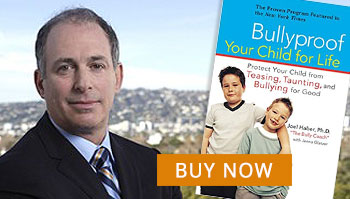 It’s important to go over likely Bullying scenarios with your child to help her rehearse what to say and do when the problem occurs.
It’s important to go over likely Bullying scenarios with your child to help her rehearse what to say and do when the problem occurs.
Forget about insulting or threatening the bully.
Forget about telling your child to “just ignore it.”
“Cute” and snappy comebacks are tough to pull off, but possible if your child feels comfortable with this strategy.
These examples are high-risk and likely to make your child look too affected by the bully’s words or actions. Even “ignoring it” usually is a reaction. When a child is clearly pretending not to hear or see, it’s a fun challenge for the bully to get louder and more abusive. It’s funny to the bully that she’s gotten to the target enough that she feels she has to pretend not to hear. And more often than not, the child is not a very good ignorer. There is usually plenty of body language to tell the bully that the bad behavior is working.
Therefore, what’s more important is to instill a sense in the child that the bullying child’s remarks and behaviors honestly don’t matter . . . therefore, you don’t need to pretend not to see or hear, you don’t need to argue or cry; you can just give a little grin and reply, “Say whatever you like” and leave it at that, or even— gasp!—agree with the bully if the teasing isn’t too bad.
Think of how many comedians America loves who rely on self-deprecating humor. Jay Leno doesn’t get offended when people tell him he has a big chin. He agrees with them and even exaggerates it to make jokes about himself. Rodney Dangerfield made a career of insulting himself—probably playing off the comments children once made about him.
If your child is going to confront the bully, whatever your child chooses to say must be said as unemotionally as possible. Bullies absolutely love it when a child is frothing at the mouth, panting, crying, yelling, stomping away . . . that virtually ensures that the harassment will continue. Practice the tone of voice with your child. If your child has a favorite “cool” celebrity, it might help to pretend to be that celebrity when delivering the lines.
Work with your child on portraying confidence—standing straight, looking people in the eye, speaking calmly and firmly.
Here are some acceptable lines your child might use, depending on his level of comfort and resilience:
Say whatever you like about me. – Maybe you’re right.
Okay, whatever you say.
Thanks!
If your child feels a little stronger and can use body language to stand up straight to bullies and look them in the eye, more assertive responses are possible:
That’s enough.
I’m not interested in fighting.
Please stop now.
This isn’t funny to me.
Knock it off.
Tell your child not to use these words, which convey too much emotion or are too threatening and will probably produce the opposite of the desired result:
Shut up.
You’re stupid.
You’re a jerk.
That’s not true!
Am not.
I’m telling.
My big brother/father/neighbor/friend could beat you up.
Liar!
Get away from me.
I hate you.
Role playing bullying scenarios with your child will help them to deal with a bully when and if he problem occurs.
